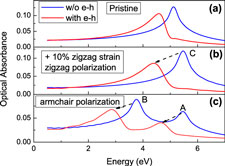Article contents
Many-electron effects on optical absorption spectra of strained graphene
Published online by Cambridge University Press: 20 December 2011
Abstract

We use the first-principles GW + Bethe–Salpeter equation approach to study the electronic structure and optical absorption spectra of uniaxial strained graphene. Applied strain induces an anisotropic Fermi velocity and tilts the axis of the Dirac cone. As a result, the optical response of strained graphene is dramatically changed; the optical absorption is anisotropic; the characteristic single optical absorption peak of pristine graphene is split into two peaks with enhanced excitonic effects. Within the infrared regime, the optical absorbance of uniaxial strained graphene is no longer a constant because of the broken symmetry and anisotropic excitonic effects. Within the visible-light regime, we observe a prominent optical absorption peak due to an enhanced red shift by electron–hole interactions, enabling us to change the visible color and transparency of stretched graphene. Finally, we also reveal enhanced excitonic effects within the ultraviolet regime, where a few nearly bound excitons are identified.
- Type
- Invited Feature Paper
- Information
- Copyright
- Copyright © Materials Research Society 2011
References
REFERENCES
- 10
- Cited by




